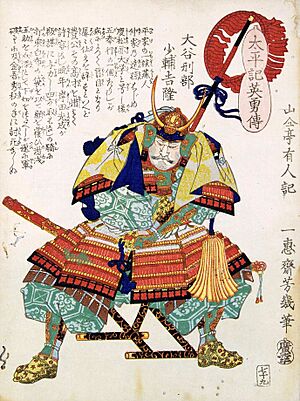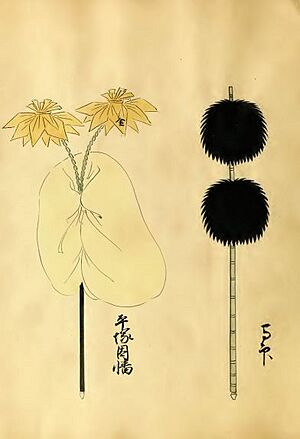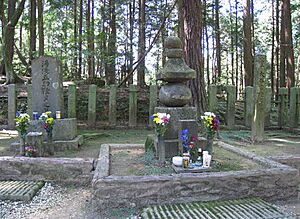Ōtani Yoshitsugu facts for kids
Quick facts for kids
Ōtani Yoshitsugu
|
|
|---|---|
| 大谷 吉継 | |

An ukiyo-e of Ōtani Yoshitsugu.
|
|
| Lord of Tsuruga Domain | |
| In office 1589–1600 |
|
| Preceded by | Hachiya Yoritaka |
| Personal details | |
| Born | 1558 or 1565 Shiga Prefecture |
| Died | October 21, 1600 (aged 41–42) or October 21, 1600 (aged 34–35) Sekigahara, Gifu Prefecture |
| Relations | Sanada Yukimura (son-in-law) Higashi-dono (mother, maid of Hideyoshi's wife Nene) |
| Children | Chikurin-in Ōtani Yoshikatsu Kinoshita Yoritsugu |
| Military service | |
| Allegiance | |
| Rank | Gyōbu Shōyū |
| Unit | |
| Battles/wars | Siege of Miki< Siege of Takamatsu Battle of Yamasaki Battle of Shizugatake Siege of Oshi Korean Campaign Battle of Sekigahara |
Ōtani Yoshitsugu (大谷 吉継, 1558 or 1565 – October 21, 1600) was a brave Japanese samurai who lived during a time of many wars, known as the Sengoku period. He was also called Junior Assistant Minister of Justice, or Gyōbu-shōyū (刑部少輔). Yoshitsugu was born in 1558. He later became a loyal follower of Toyotomi Hideyoshi, a powerful leader in Japan. He fought in important battles like the Odawara campaign and the Korean campaign.
Contents
Who Was Ōtani Yoshitsugu?
Ōtani Yoshitsugu is famous in Japan for two main things: his serious illness and his strong friendship with Ishida Mitsunari. People believed he valued friendship above all else. It's thought that their close bond grew during the Korean campaign, where they worked together.
There's a well-known story about their friendship. Once, at a special tea party, a cup of tea was being passed around. When Yoshitsugu drank from it, a small accident happened, and something fell into the cup. He noticed it too late, as the cup was already moving to the next person. Everyone looked uncomfortable when it was their turn. But when the cup reached Mitsunari, he calmly drank all the remaining tea. He even said it was delicious! This act of kindness deeply touched Yoshitsugu.
His Early Life and Names
There's a popular story about Yoshitsugu's childhood name, Keimatsu. Before he was born, his father wished for a son. One day, his mother prayed at a shrine. A pine tree fell nearby, and she ate a piece of its branches for good luck. When her son was born, his father named him after the pine tree, grateful for the god's answer.
Yoshitsugu had other names too. His first official name was Heima. He might have received this name for leading cavalry (soldiers on horseback) or for his service in the Siege of Miki. Later, he was also known as Kinosuke or Norinosuke. He was also called Ōtani Gyōbu, which was a respectful name linked to his higher rank.
When Yoshitsugu became ill, his skin looked very pale. This led to his nickname "White Face" (白頭). Legends say he also wore a white mask to cover his face, which was common for people with his condition.
His Health and the Battle of Sekigahara
Before the big Battle of Sekigahara, Yoshitsugu tried to convince his friend Mitsunari not to fight. He thought it was a losing battle. However, seeing how determined Mitsunari was, Yoshitsugu decided to join him after thinking for several days.
At this time, Yoshitsugu's health was getting worse. He was nearly blind and couldn't stand or fight on his own. He had to be carried to the battlefield in a special chair called a palanquin.
Ōtani and Mitsunari's Friendship
Ōtani Yoshitsugu is often seen as a heroic and talented friend of Ishida Mitsunari in stories and poems. They are said to have been good friends since they first worked for Toyotomi Hideyoshi. They respected each other's ideas and character.
The famous tea ceremony story from 1587 shows their bond. Yoshitsugu, who was ill, accidentally left a mark in the tea bowl. Other guests avoided drinking from it. But Mitsunari drank it all without hesitation, saying the tea was delicious. This gesture deeply moved Yoshitsugu. Many believe this event made him decide to fight alongside Mitsunari in the Western army.
While the tea ceremony story was written down by people who lived at that time, historians still discuss how close their friendship truly was. Stories from later periods often describe Yoshitsugu as a very honorable and talented samurai. However, historical records don't always have many details to support these claims.
Yoshitsugu had three sons and one daughter. His second son died with him at Sekigahara. His daughter, Chikurin-in, married Sanada Yukimura. She was the mother of his two sons, Sanada Daisuke and Sanada Daihachi.
Serving Under Hideyoshi
Yoshitsugu came from humble beginnings. Under Hideyoshi, he became a kōshō. This was a special role where he handled important secretarial tasks. A kōshō also acted as a human shield to protect their lord, even risking their own life. Because of this, kōshō had to be smart, polite, and skilled in fighting.
Yoshitsugu might have started as a low-ranking kōshō or worked with Mitsunari in the 1570s. Many stories say his intelligence and charm helped him make many friends. His early achievements with Hideyoshi are not fully known. However, most sources agree he was among the 700 people who supported Hideyoshi after a major event called the Incident at Honnōji. He helped take Nagahama Castle from Hideyoshi's enemy. Hideyoshi is said to have praised Yoshitsugu, saying, "Give me a million troops and I would love to see him guide them."
During the Battle of Shizugatake, Yoshitsugu fought for Hideyoshi. What he did exactly is unclear, with different legends. One story says he used his cleverness to convince an enemy to surrender. Another describes him as a brave warrior who performed great deeds with his spear. Some texts say Hideyoshi greatly praised both Yoshitsugu and Mitsunari for their actions in this battle.
What we know for sure is that Yoshitsugu was named Gyōbu-shōyū (a minor Minister of Justice) in 1585. By this time, he was considered one of the most important people in Hideyoshi's inner circle.
Around 1585, Yoshitsugu became seriously ill. While historical records don't give many details, people generally believe he had leprosy, based on stories from later times. This illness greatly affected his ability to travel and fight in campaigns.
He was rewarded with land and became the lord of Tsuruga Castle. In 1590, he joined Mitsunari in the Odawara campaign and was present at Oshi Castle. He also took part in the Korean Campaign.
After returning from Korea, Yoshitsugu was welcomed as a hero by Hideyoshi. From then on, Yoshitsugu swore his loyalty to the Toyotomi family.
The Battle of Sekigahara
After Hideyoshi's death, Yoshitsugu first planned to join Tokugawa Ieyasu, another powerful leader. In 1599, Yoshitsugu moved his troops with Ieyasu's forces. However, Mitsunari invited Yoshitsugu to his castle. Even though Yoshitsugu was nearly blind from his illness, he was surprised to find armed soldiers waiting for him.
Mitsunari introduced Yoshitsugu to his loyal follower, Shima Kiyooki. Kiyooki changed Yoshitsugu's mind about Mitsunari's Western army. Yoshitsugu initially thought Mitsunari couldn't win and wanted to stay with Ieyasu. But for some reason, Mitsunari convinced him to switch sides and join the Western army. A legend says Ieyasu was surprised by Yoshitsugu's sudden change of loyalty.
Why Yoshitsugu changed his mind is still a mystery. Many stories exist, but they lack strong historical proof. The most popular story, from the Edo Period, says he joined out of friendship. In this version, Mitsunari asked him three times to join. Even though Yoshitsugu knew it was a losing cause, he couldn't abandon his friend. Another story says his daughter's safety was at risk, forcing him to join.
Whatever the reason, Yoshitsugu fought for the Toyotomi family. He led an army of about 6,500 men. He commanded 600 troops himself, with others led by his trusted friends and his son, Ōtani Yoshikatsu.
Yoshitsugu was aware that Kobayakawa Hideaki, an ally, might betray them. He positioned his army to watch Kobayakawa's movements, hoping to protect his allies from the expected betrayal.
During the battle, Kobayakawa Hideaki's army of 15,000 soldiers suddenly charged down the mountain towards Yoshitsugu's position. Yoshitsugu's army bravely stood as a shield against their attack. His elite troops fought back fiercely, even pushing Kobayakawa's forces back up the mountain at one point. However, the sheer number of enemy soldiers was too great. Yoshitsugu's defenses were overwhelmed from all sides. He died in the battle. A grave marker was placed for him at Sekigahara.
His Grave
The photo of his grave shows his loyal retainer Yuasa Gosuke's grave behind and to the left, guarding Yoshitsugu even after death. To the right is the grave of Otani Yoshitaka, who might have been his son Yoshikatsu. Although the central stone monument doesn't have a name, it is believed to be Yoshitsugu's because of its central position and the relationship between the graves.
No matter if he was a hero or not, Yoshitsugu is remembered for his samurai spirit and his loyalty. His tragic end against overwhelming odds is one of the many famous stories from the Battle of Sekigahara.



